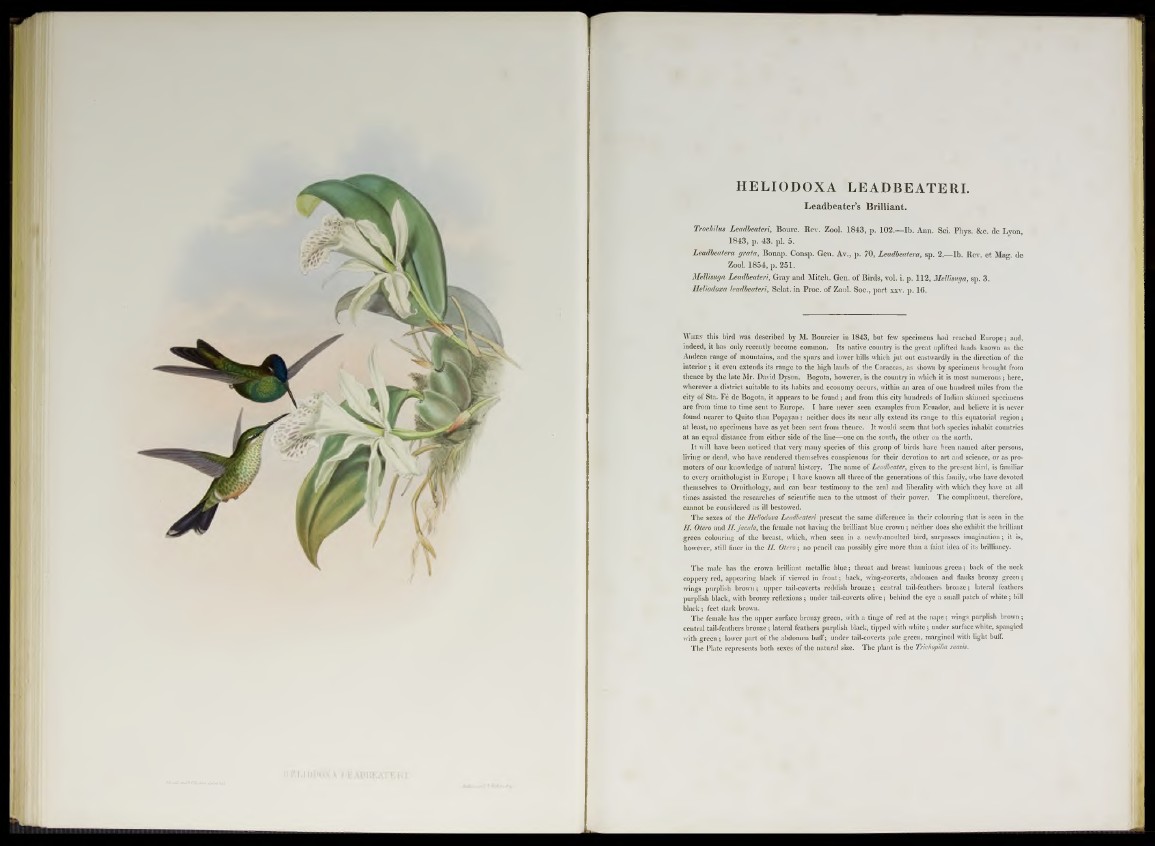
JSmUvuUICRu-tilrr.ddUlttJ,
H E L M
HELIODOXA LEADBEATERI.
Leadbeater’s Brilliant.
Trochïlus Leadbeateri, Bourc. Rev. Zool. 1843, p. 102.—Ib. Ann. Sci. Phys. &c. de Lyon,
1843, p. 43. pl. 5.
Leadbeatera grata, Bonap. Consp. Gen. Av., p. 70, Leadbeatera, sp. 2.—Ib. Rev. et Mag. de
Zool. 1854, p. 251.
Mettisuga Leadbeateri, Gray and Mitcb. Gen. of Birds, vol. i. p. 112, Mellimga, sp. 3.
Heliodoxa leadbeateri, Sclat. in Proc. of Zool. Soc., p art xxv. p. 16.
W h e n this bird was described by M. Bourcier in 1 8 4 3 , but few specimens had reacbed Europe; and,
indeed, it bas only recently become common. lts native country is the great uplifted lands known as the
Andean range of mountains, and the spurs and lower hills which jut out eastwardly in the direction of the
interior; it even extends its range to the high lands of the Caraccas, as shown by specimens brought from
thence by the late Mr. David Dyson. Bogota, however, is the country in which it is most numerous; here,
wherever a district suitable to its habits and economy occurs, within an area of one hundred miles from the
city of Sta. Fé de Bogota, it appears to be found; and from this city hundreds of Indian skinned specimens
are from time to time sent to Europe. I have never seen examples from Ecuador, and believe it is never
found nearer to Quito than Popayan : neither does its near ally extend its range to this equatorial region;
at least, no specimens have as yet been sent from thence. It would seem that both species inhabit countries
at au equal distance from either side of the line—one on the south, the otlier on the north.
It will have been noticed that very many species of this group of birds have been named after persons,
living or dead, who have rendered themselves conspicuous for their devotion to art and Science, or as pro-
moters of our knowledge of natural history. The name of Leadbeater, given to the present bird, is familiar
to every ornithologist in Europe; I have known all three of the generations of this family, who have devoted
themselves to Ornithology, and can bear testimony to the zeal and liberality with which they have at all
times assisted the researches of scientific men to the utmost of their power. The compliment, therefore,
cannot be considered as ill bestowed.
The sexes of the Heliodoxa Leadbeateri present the same difference in their colouring that is seen in the
H Otero and H. jacula, the female not having the brilliant blue crown ; neither does she exhibit the brilliant
green colouring of the breast, which, when seen in a newly-moulted bird, surpasses imagination; it is,
however, still finer in the H. Otero; no pencil can possibly give more than a faint idea of its brilliancy.
The male has the crown brilliant metallic blue; throat and breast luminous green; back of the neck
coppery red, appearing black if viewed in front; back, wing-coverts, abdomen and flanks bronzy green;
wings purplish brown; upper tail-coverts reddish bronze; central tail-feathers bronze; lateral feathers
purplish black, with bronzy reflexions; under tail-coverts olive; behind the eye a small patch of white; bill
black; feet dark brown.
The female has the upper surface bronzy green, with a tinge of red at the nape; wings purplish brown ;
central tail-feathers bronze; lateral feathers purplish black, tipped with white; under surface white, spangled
with green; lower part of the abdomen buff; under tail-coverts pale green, margined with light buff.
The Plate represents both sexes of the natural size. The plant is the Trichopilia suavis.